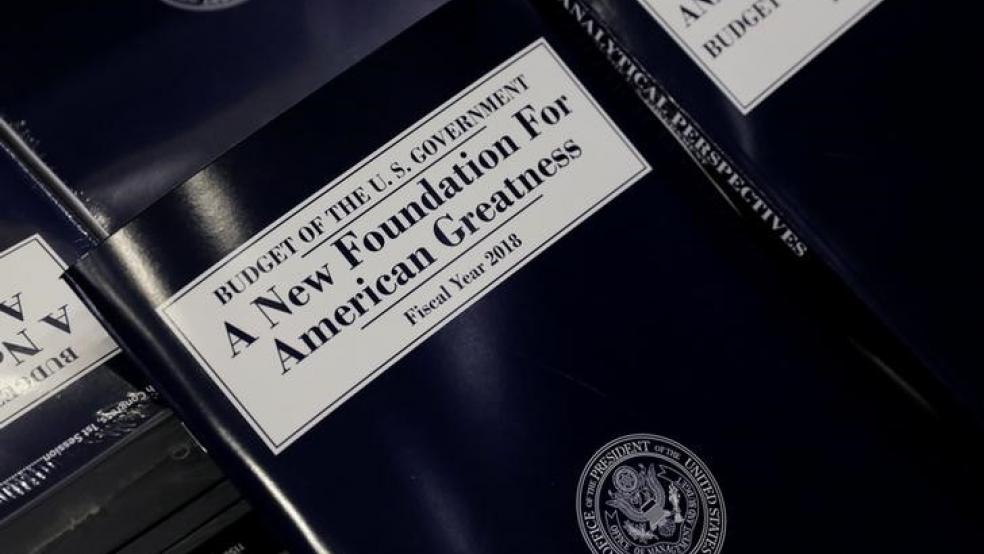“It’s a billion here and a billion there,” The New York Times once observed of the federal budget in 1938, “and by and by it begins to mount up into money.” Eighty federal budgets later, the unit of measure has increased by a thousand. The Office of Management and Budget released their new, fully fleshed out budget proposal for fiscal year 2018, and it didn’t take long for critics to find a massive math error in their ten-year projections.
That certainly qualifies as news – if math had anything to do with presidential budget proposals. Or, more broadly, with federal budgets at all.
Related: Trump Budget Finds $0 in Wasteful Pentagon Programs. Are They Kidding?
The problem starts with an assumption built into the financial projections of the budget proposal from OMB chief Mick Mulvaney. Donald Trump campaigned on a promise to enact economic policies that would produce annual growth in gross domestic product (GDP) consistently higher than 3 percent. The US economy has not seen that level of growth in a single year since 2004, and not in consecutive years since the dot-com bubble period of 1996-2000, according to the Bureau of Economic Analysis, but that promise was key to Trump’s election – and he has to deliver on it to pay for some of his other initiatives.
That may be the problem. Mulvaney’s budget assumes an even higher level of growth over the next ten years. The Trump budget projects a constant rate of real GDP growth of 3 percent from 2021 to 2027, a rate that has not been sustained for that long in the last several decades, at least. As CNN Money notes, the 2004 peak came as part of the housing bubble and since the collapse, has never come close to sustained growth at that rate.
Sustained 3 percent growth over seven years would be fantastic … in the literal sense of the word. If Trump delivered that kind of economic expansion – and that’s a mighty big if – it would greatly expand job creation, kickstart innovation and business expansion, and therefore revenue from business and personal income taxes. OMB estimates that the federal government would get an extra $2 trillion over current projections in the next ten years.
Related: Why Trump's Tax Cuts May Not Spur a Corporate Spending Boom
That’s where the math error appears. Having assumed $2 trillion in extra federal revenue, Mulvaney applied the entire amount twice to the budget. First, the windfall is highlighted as deficit reduction in a promise to balance the budget by 2027, but it’s also used to offset the deficit impact of the tax reform package the White House has pushed to get the economic growth it needs for its budget assumptions. Former Treasury Secretary Lawrence Summers called it “the most egregious accounting error in a presidential budget in the nearly 40 years I have been tracking them.”
No worries, Mulvaney assured the press, saying that the calculation was done “on purpose,” and that “we stand by the numbers.” Current Treasury Secretary Steve Mnuchin was a little more circumspect. “This is a preliminary document that will be refined,” Mnuchin said when asked about the error in a separate press briefing, despite having months to prepare the proposal.
Mnuchin’s correct, although not for the reasons one might think. Presidential budget proposals have no formal role in crafting federal budgets. That task falls to Congress, where the House of Representatives begin the process of raising revenue and spending it. OMB proposals might inform Congress of presidential priorities in spending and tax policy, but Congress has no particular requirement to use any of the proposals, or to follow the same assumptions, as the White House.
So why bother to produce them at all? They are entirely political documents, meant to frame the budget debate that will take place over the next several months. It gives Congress some measure of what a president will approve, and what will trigger vetoes when the appropriations bills get crafted for the September 30th deadline. Perhaps especially for first budgets, they set the tone for a presidential term’s fiscal outlook and policy.
Related: 9 Top Takeaways From Trump’s $4 Trillion Federal Budget
In this case, the White House has set a tone of austerity and pro-growth economic policies. Trump made large cuts in projected spending for safety-net programs just to hold overall spending growth to 3.5 percent per year, thanks to his promise to leave entitlement programs alone. The depth of those cuts shifts the “Overton window” of acceptable outcomes to allow Republicans to argue for real cuts that do not cut as deeply but do result in actual reductions. In Trumpian Art of the Deal terms, it’s the “big ask” that allows for substantial wins in the end.
Unfortunately, in this case, the extreme nature of the underlying assumptions of the budget, combined with the duplicative use of questionable revenue outcomes, undermines the credibility of this big ask. The pay-for on tax reform relies on a sustained rate of growth that the US hasn’t seen for a single year in two decades, which makes the cuts to safety-net programs a greater risk. The math doesn’t add up.
In the end, though, that’s been true of federal budgets for decades. Despite having the largest economy in the world, we borrow 40 cents on the dollar to fund the federal government. Presidents and Congresses over the last 40 years pretend that this is a temporary solution and that Americans can go on forever without choosing between government largesse and fiscal responsibility.
Perhaps this highly unrealistic proposal will make that lesson so clear that we will stop ignoring that fact and start making some hard choices about entitlement programs, defense policy, safety-net means testing and efficient taxation. If so, it might ironically become the best budget proposal in decades, but don’t bet $2 trillion on it.
This article was corrected updated at 9:37 am.






